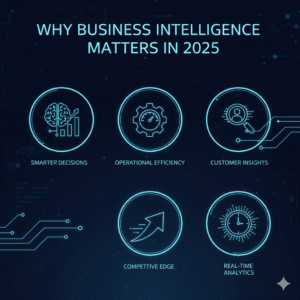A Full Guide to Customer Experience in the Age of AI
Customer experience is now the most important thing that sets businesses apart in every field. In the past, companies mostly competed on price or product features. Now, customers expect smooth, personalized interactions at every point of contact. AI is changing the way businesses meet these needs by giving them new ways to understand, predict, and meet customer needs.
Using AI to improve customer experience isn’t just about adding chatbots or recommendation engines; it’s a big change in how businesses deal with customers. Companies that use AI to improve customer experience see big jumps in satisfaction scores, retention rates, and overall business performance.
This in-depth guide looks at how AI is changing the way customers interact with businesses, from personalized service on a large scale to predictive customer service. We’ll look at how this change can be used in the real world, talk about the problems that come up when putting it into action, and give businesses that are ready to make the change some useful tips. This guide will help you use smart technology to give your customers amazing experiences, whether you’re just starting out with AI or trying to improve projects that are already in place.
How AI is Changing the Way Customers Feel
Personalization on a Large Scale
One of AI’s best contributions to customer experience is its ability to give millions of customers personalized experiences at the same time. Personalization in the past needed a lot of manual segmentation and had few options for customization. This is totally different now that AI is here.
Machine learning algorithms look at huge amounts of data, like browsing history, buying patterns, demographic information, and real-time behavior, to make detailed profiles of customers. These profiles let businesses send out content, product suggestions, and service interactions that feel like they were made just for each person.
Recommendations and content that are tailored to you by AI
These days, recommendation engines can do a lot more than just show you “customers who bought this also bought” suggestions. Advanced AI systems take into account things like seasonal preferences, life stage indicators, social influences, and even mood-based patterns found in interaction data.
Streaming services use this method by looking at your viewing history, your preferences for what time of day you watch, how you use your devices, and how often you finish shows to suggest content that fits both your explicit preferences and your more subtle behavioral cues. This level of personalization keeps customers interested and cuts down on churn by a large amount.
Personalization that predicts
AI’s ability to predict what customers want before they say it is probably even more impressive than reactive personalization. Predictive personalization uses machine learning models to identify patterns that indicate future behavior or preferences.
Predictive personalization helps e-commerce sites show customers products they didn’t know they wanted. Service providers use it to figure out when customers might need help or extra services. This proactive approach makes customers happy, which helps build relationships and grow the business.
Better service for customers
AI has completely changed customer service, going from reactive support to proactive help that is available 24/7.
Chatbots and virtual assistants that use AI
AI chatbots today are very different from the rule-based ones that came before them. Natural language processing enables these systems to understand context, sentiment, and intent with remarkable accuracy. They deal with complicated questions, keep the context of a conversation going across several interactions, and easily pass problems on to human agents when necessary.
The most advanced virtual assistants can connect to backend systems to do things like process returns, change account information, or set up appointments. This feature changes customer service from a place to get information to a place to finish a transaction.
Automated support processes and smart routing
AI streamlines support operations by automatically categorizing and routing customer inquiries to the most appropriate resources. Machine learning models look at the content of tickets, the history of the customer, and indicators of how urgent the request is to find the best routing paths.
This smart routing cuts down on response times by a lot and makes sure that customers talk to agents who have the right skills. Priority scoring algorithms find customers who are worth a lot or problems that need to be fixed right away. This makes service better and customers happier.
Available 24/7 and ready to help right away
AI-powered support systems always offer the same level of service, no matter what time it is, how many requests there are, or how complicated they are. Customers receive immediate responses to common questions while complex issues are properly triaged for human follow-up.
This constant availability is especially helpful for global businesses that serve customers in different time zones. Customers don’t have to wait until business hours to get basic help or information anymore.
Customer Insights Based on Data
AI turns raw customer data into useful information that helps businesses make strategic decisions and improve their operations.
Using AI analytics to learn about how customers act
Advanced analytics platforms look at customer interaction data from many sources to find patterns that traditional analysis methods can’t see. These insights help businesses figure out what customers do, find problems, and improve experiences based on what people actually do instead of what they think they should do.
Machine learning models find small links between what customers do and what happens, which helps businesses make decisions about how to improve their products, marketing, and services based on data.
Sentiment Analysis for Customer Satisfaction
AI-powered sentiment analysis goes beyond basic satisfaction surveys to figure out how customers feel by looking at how they interact with each other. Natural language processing looks at customer communications like emails, chat messages, social media posts, and reviews to see how satisfied they are and how they feel.
Businesses can find unhappy customers before they leave and respond proactively to concerns thanks to real-time sentiment monitoring. Sentiment trends also give useful information about changes in policies, product launches, or service changes.
Finding Pain Points and Chances to Make Things Better
AI is great at recognizing patterns, which makes it especially good at finding problems that affect the customer experience in a consistent way. AI systems can find the exact points in a customer’s journey where problems happen all the time by looking at support tickets, user behavior flows, and feedback data.
These insights help businesses fix the real problems instead of just the symptoms, which leads to long-lasting improvements in the quality of the customer experience.
Engaging customers before they need help
The change from reactive to proactive customer engagement is a big change in how businesses deal with their customers..
Anticipating Customer Needs
Predictive models look at past data and current behavior patterns to figure out when customers might need help, more products, or better service. This forward-thinking method lets businesses contact customers with helpful information or deals before they have problems or realize they need something.
This is how subscription services find customers who are likely to cancel and offer them solutions or incentives to keep them. In the same way, financial services companies might notice spending patterns that show a customer could use different account features or financial products.
How to Cut Down on Churn by Acting Early
AI-powered churn prediction models identify at-risk customers based on engagement patterns, usage metrics, and behavioral indicators. These models enable businesses to implement retention strategies while customers are still engaged rather than after they’ve already decided to leave.
Personalized offers, proactive support outreach, or feature recommendations that deal with the root causes of customer dissatisfaction are some examples of early intervention strategies.
Things to Think About and Problems
Bias and moral issues
When using AI to improve customer service, you need to be very careful about ethical issues and possible bias that could hurt customer relationships or lead to unfair treatment.
Addressing Algorithmic Bias
AI systems learn from historical data that may have built-in biases based on past decisions made by people or unfairness in society. These biases can lead to unfair treatment of some groups of customers, such as higher prices, worse service, or different product recommendations.
Companies need to regularly check their AI systems for bias and take steps to fix any problems they find to make sure that all customers are treated fairly. This necessitates varied development teams, extensive testing procedures, and continuous oversight of AI decision-making trends.
Building Trust and Openness
Customers want to know more and more about how AI systems make choices that affect their experiences. Black-box algorithms that can’t explain why they do what they do can make people lose trust and may break new rules that require algorithms to be open about how they work.
Companies should use AI systems that can explain their recommendations or decisions in a clear way. This openness helps businesses find and fix problems with AI behavior and builds trust with customers.
Data Privacy and Security
AI-powered customer experiences need a lot of data to be collected and analyzed, which makes privacy and security a big problem that businesses need to deal with before it happens.
Keeping Customer Data Safe
AI systems require access to detailed customer information to deliver personalized experiences, but this data concentration creates attractive targets for cybercriminals. To keep customer information safe, businesses need to use strong security measures like encryption, access controls, and monitoring systems.
AI implementations should follow the principles of data minimization, which means only collecting the information that is needed and keeping it only as long as it is needed for business purposes.
Regulatory Compliance
GDPR and CCPA are two privacy laws that set strict rules for how businesses can gather, use, and store customer data. AI systems must comply with these regulations while still delivering valuable customer experiences.
To be compliant, you need to think carefully about consent mechanisms, the reasons for processing data, and customer rights, such as the right to access, correct, and delete their data.
Problems with implementation and integration
To use AI to improve customer experience, you need to overcome big technical and organizational problems.
System Integration Complexity
Most businesses still use old systems that weren’t made to work with new AI platforms. It takes a lot of planning and technical know-how to add AI features to existing customer relationship management, e-commerce, and support systems.
It is important to carefully plan API development, data synchronization, and workflow integration so that everything works smoothly and doesn’t interfere with processes that customers already use.
Change Management and Training for Employees
AI changes how employees do their jobs and how they talk to customers. To be successful, AI needs to be fully understood by employees through thorough training programs and change management initiatives.
AI shouldn’t replace people; instead, it should help them do their jobs better and let them focus on more important tasks that need human judgment, creativity, and emotional intelligence.

Best Ways to Use AI to Improve Customer Service
Set Clear Goals First
Clearly defined goals and success metrics that are in line with the company’s overall goals are the first steps to a successful AI implementation.
Setting Specific Goals and KPIs
Rather than implementing AI for its own sake, organizations should identify specific customer experience challenges or opportunities that AI can address. These could be things like lowering response times, making personalization more accurate, or raising customer satisfaction scores.
Before implementation starts, key performance indicators (KPIs) should be set up. These will give you clear ways to measure how well AI works and how much money you get back.
Putting more effort into important areas
Implementing AI takes a lot of time, money, and changes to how things are done in the company. Companies should focus on the areas where AI can make the biggest difference for customers and the business.
Some common areas that have a big effect are automating customer service, marketing to individuals, and using predictive analytics to keep customers from leaving.
Put Data Quality First
The quality of the data is the only thing that matters for AI to work well. If the data is bad, AI won’t work well and customers may have bad experiences.
Making sure the data is correct and consistent
Companies need to set up data governance processes that make sure that customer information is correct, complete, and formatted the same way in all systems. Before AI can be put into use, a lot of work may need to be done to clean up and standardize the data.
To keep AI working well over time as new data is collected and processed, data quality monitoring should be done on a regular basis.
Using More Than One Data Source
The best AI systems use data from many different sources to make full customer profiles. This could include things like how people use the website, what they buy, how they interact with support, what they do on social media, and their demographic information.
When combining data from different sources, it’s important to think about data privacy, security, and quality.
Take a customer-centered approach
AI should be used to make customers’ experiences better, not just to cut costs or make things run more smoothly.
Understanding Customer Needs and Preferences
AI development priorities should be based on regular customer research and feedback. Companies can focus their AI work on the areas that will have the biggest positive effect if they know what their customers value most in their interactions.
Journey mapping exercises can help find specific points of contact where AI can make things easier or better for customers.
Constantly improving based on feedback
AI systems need to be constantly watched and improved based on how well they work and what customers say. This iterative method makes sure that AI implementations keep meeting the needs and expectations of customers as they change.
Encourage teamwork and new ideas
For AI to work, people in different departments need to work together and be open to trying new things and learning from their mistakes.
Working together across departments
People from customer service, marketing, sales, IT, and legal departments should all be involved in AI projects to make sure that all aspects and needs are fully considered.
Regular communication and collaboration help make sure that AI projects help the business as a whole instead of just improving the metrics of one department at the expense of the customer experience.
Creating a culture of innovation
Companies should allow people to try out AI technologies while still following good risk management practices. This could include pilot programs, test environments for new AI features, and chances for employees to learn.
What will happen with AI and customer experience in the future?
Advanced AI for Hyper-Personalization
The next generation of AI-powered personalization will give people experiences that are not only based on their preferences, but also on the current situation and their emotional state.
Changing things in real time based on the situation
Advanced AI systems will use real-time data about the environment and the situation to tailor experiences based on things like location, time of day, weather, device usage, and the current situation.
This level of personalization will make each customer interaction different, going from static profiles to dynamic, context-aware customization.
Making customer experiences more immersive
New technologies like augmented reality and voice interfaces will open up new ways for AI to personalize things, making experiences that feel natural and intuitive.
Emotional Intelligence Powered by AI
In the future, AI systems will be able to better understand and respond to how customers feel, which will make interactions more caring and useful.
Recognizing and responding to emotions
AI systems will be able to pick up on subtle emotional cues in customer communications and respond appropriately thanks to advanced natural language processing and sentiment analysis.
This emotional intelligence will help AI systems know when to escalate issues to human agents, adjust communication styles, or proactively offer support based on detected frustration or confusion.
Building Stronger Customer Relationships
AI systems that understand and respond to emotions will help businesses build stronger, more meaningful relationships with customers by demonstrating empathy and care in their interactions.
Seamless Omnichannel Integration
AI will increasingly orchestrate customer experiences across all touchpoints, ensuring consistency and continuity regardless of how customers choose to interact with businesses.
Unified Customer Profiles Across Channels
Advanced AI systems will maintain comprehensive customer profiles that update in real-time across all interaction channels, ensuring that customers receive consistent service whether they contact support via phone, chat, email, or social media.
Intelligent Channel Optimization
AI will help businesses determine the optimal channels for different types of customer interactions, automatically routing customers to the most effective touchpoints based on their preferences, issue complexity, and desired outcomes.
AI-Augmented Human Employees
Rather than replacing human workers, future AI implementations will focus on augmenting human capabilities and enabling employees to deliver better customer experiences.
Empowering Employees with AI Tools
AI will provide employees with real-time insights, recommendations, and information that help them serve customers more effectively. This might include customer history summaries, next-best-action suggestions, or emotional intelligence indicators.
Enhancing Job Satisfaction Through AI Support
By automating routine tasks and providing intelligent assistance, AI will enable employees to focus on creative, strategic, and relationship-building activities that provide greater job satisfaction and career development opportunities.
Building the Future of Customer Experience
The transformation of customer experience through AI represents both an unprecedented opportunity and a significant responsibility for businesses across all industries. Organizations that successfully implement AI for customer experience will create competitive advantages through superior personalization, efficiency, and customer satisfaction.
Success requires more than just technology implementation—it demands a customer-centric approach that prioritizes ethical considerations, data privacy, and continuous improvement based on customer feedback. The businesses that thrive will be those that view AI as a tool for enhancing human connections rather than replacing them.
The future belongs to organizations that can seamlessly blend artificial intelligence with human expertise, creating customer experiences that are both highly efficient and genuinely empathetic. This balance will define the next generation of customer experience excellence.







